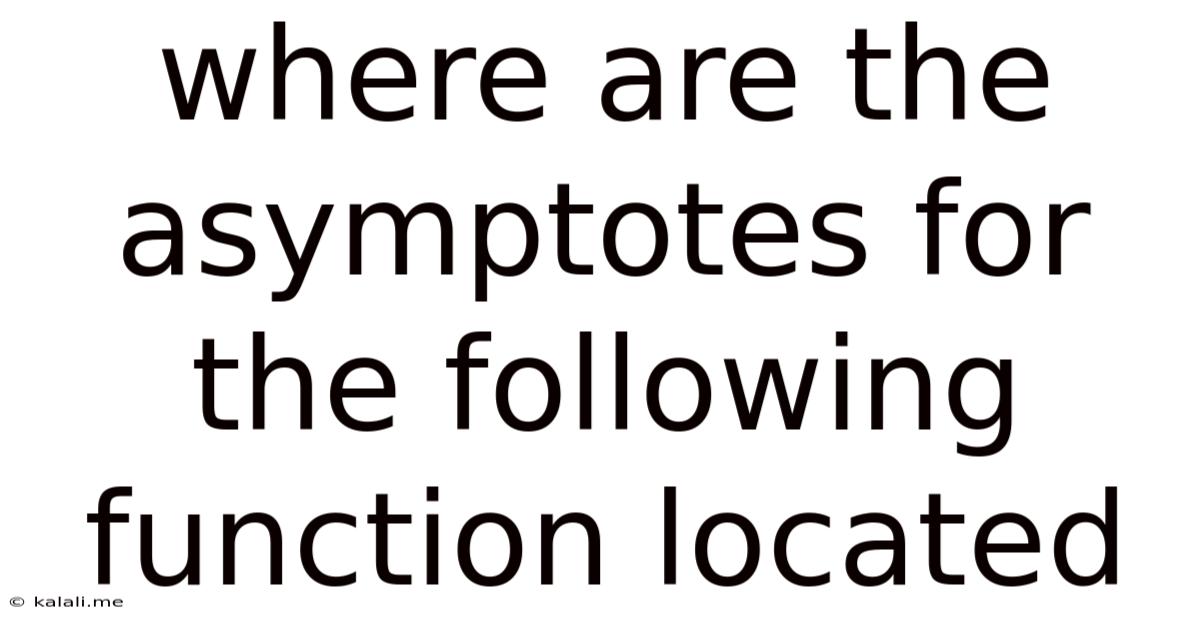Where Are The Asymptotes For The Following Function Located
Kalali
May 10, 2025 · 3 min read

Table of Contents
Finding Asymptotes: A Comprehensive Guide
This article will guide you through the process of identifying vertical, horizontal, and slant asymptotes for a given function. Understanding asymptotes is crucial for comprehending the behavior of a function, particularly its end behavior and any discontinuities. We'll explore different methods and provide examples to solidify your understanding. Finding the asymptotes of a function helps you accurately sketch its graph and analyze its properties.
What are Asymptotes?
Asymptotes are lines that a curve approaches arbitrarily closely, as it tends towards infinity. They represent the boundaries a function's graph will never cross, though it may get infinitely close. There are three main types:
-
Vertical Asymptotes: These occur at values of x where the function approaches positive or negative infinity. They are often found where the denominator of a rational function is zero and the numerator is non-zero.
-
Horizontal Asymptotes: These occur as x approaches positive or negative infinity. They describe the function's behavior at the extremes of its domain.
-
Slant (Oblique) Asymptotes: These occur when the degree of the numerator is exactly one greater than the degree of the denominator in a rational function.
How to Find Asymptotes
Let's examine how to locate each type of asymptote. Remember, the specific function will determine which types of asymptotes exist.
1. Finding Vertical Asymptotes
Vertical asymptotes typically occur at values of x that make the denominator of a rational function equal to zero, provided the numerator is non-zero at those points. If both the numerator and denominator are zero at a particular x value, further investigation (using L'Hôpital's Rule or factoring) is needed to determine the behavior of the function.
Example: Consider the function f(x) = 1/(x-2). The denominator is zero when x = 2. The numerator is non-zero at x=2. Therefore, there's a vertical asymptote at x = 2.
2. Finding Horizontal Asymptotes
Horizontal asymptotes describe the end behavior of the function. For rational functions, we compare the degrees of the numerator and denominator:
- Degree of numerator < Degree of denominator: The horizontal asymptote is y = 0.
- Degree of numerator = Degree of denominator: The horizontal asymptote is y = (leading coefficient of numerator) / (leading coefficient of denominator).
- Degree of numerator > Degree of denominator: There is no horizontal asymptote; there may be a slant asymptote (see below).
Example: For f(x) = (2x² + 1) / (x² - 4), the degrees are equal. The horizontal asymptote is y = 2/1 = 2. For g(x) = 1/x, the degree of the numerator is less than the degree of the denominator, so the horizontal asymptote is y = 0.
3. Finding Slant Asymptotes
Slant asymptotes occur when the degree of the numerator is exactly one greater than the degree of the denominator. To find the equation of the slant asymptote, perform polynomial long division of the numerator by the denominator. The quotient (ignoring the remainder) is the equation of the slant asymptote.
Example: Consider h(x) = (x² + 2x + 1) / (x + 1). Performing long division yields x + 1. Therefore, the slant asymptote is y = x + 1.
Conclusion
Identifying asymptotes is a critical skill in function analysis. By systematically examining the behavior of the function as x approaches infinity and points of discontinuity, we can accurately determine the presence and location of vertical, horizontal, and slant asymptotes. This improves our understanding of the function's graph and its overall properties. Remember to always consider the specific characteristics of each function to correctly identify all types of asymptotes. Mastering this skill enhances your ability to graphically represent and analyze mathematical functions effectively.
Latest Posts
Latest Posts
-
Pokemon Mystery Dungeon Red Rescue Team Codes
Jul 05, 2025
-
How Much Is 25 20 Dollar Bills
Jul 05, 2025
-
How Many Apples In 3 Lb Bag
Jul 05, 2025
-
What Is Half A Quarter Of 400
Jul 05, 2025
-
How Do You Make A Vegetable Necklace
Jul 05, 2025
Related Post
Thank you for visiting our website which covers about Where Are The Asymptotes For The Following Function Located . We hope the information provided has been useful to you. Feel free to contact us if you have any questions or need further assistance. See you next time and don't miss to bookmark.